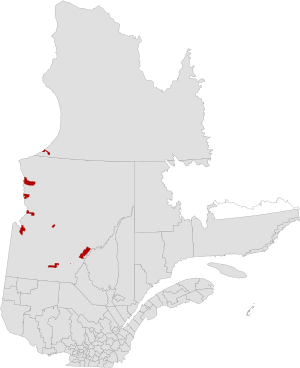Grand Council of the Crees facts for kids
| Country | Canada |
|---|---|
| Province | Quebec |
| Nation | Eeyou Istchee |
| Website | cngov.ca |
| Offices | |
| Head | Nemaska (ᓀᒥᔅᑳᐤ) |
| Additional | |
| Grand Council | |
| Grand Chief | Mandy Gull-Masty |
| Deputy Grand Chief | Norman A. Wapachee |
| Chiefs |
List
|
| Representatives |
List
|
The Grand Council of the Crees (Eeyou Istchee), or GCC(EI), is a special group that represents about 18,000 Cree people. The Cree people call themselves "Eeyou" or "Eenou." They live in a territory called Eeyou Istchee, which means "The People's Land." This land is in the James Bay and Nunavik areas of Northern Quebec, Canada.
The Grand Council helps make important decisions for the Cree Nation. It has twenty members. These include a Grand Chief and a Deputy-Grand Chief. There are also ten Chiefs elected by each Cree community. Finally, there is one other representative from each community.
The Grand Chief is like the main leader. Currently, Mandy Gull-Masty is the Grand Chief. She was elected on July 29, 2021. The Deputy Grand Chief is Norman A. Wapachee. The main office of the Grand Council is in Nemaska, a Cree community. They also have offices in big cities like Montreal, Ottawa, and Quebec City.
Contents
The Story of the Grand Council
The Grand Council was created in 1974. This happened because of a big disagreement. It was called the James Bay Cree hydroelectric conflict. This conflict started in 1971.
Why the Grand Council Was Formed
Before the Grand Council, the Eeyou Istchee territory had a traditional way of life. Cree leaders, called "ucimâu," managed the land. They made sure resources were used wisely. This system helped the Eeyou people live across their vast territory.
In 1971, the James Bay Project was announced. This project planned to build large dams for electricity. The Cree people needed a stronger voice to protect their rights. So, they formed the Grand Council. This new group represented the Cree Nation in talks with the Quebec and Canadian governments.
Important Agreements
These talks led to a major agreement. It was called the James Bay and Northern Quebec Agreement. This agreement was signed in November 1975. It was a big step for the Cree Nation.
Later, on July 24, 2012, the Quebec government signed another agreement with the Eeyou Nation. This agreement changed how the region was governed. It led to the creation of the Eeyou Istchee James Bay Regional Government. This new government replaced an older municipality.
Cree Nation Government
The Cree Nation Government (CNG) was formed in 1978. It was first known as the Cree Regional Authority (CRA). The CNG is the main group that manages the Cree Nation of Eeyou Istchee. It provides important programs and services to all Cree communities.
What the CNG Does
The Cree Nation Government is in charge of protecting the environment. It also represents the Cree Nation to the Quebec and Canadian governments. Even though the CNG and the Grand Council of the Crees are separate in law, they work very closely. They have the same members and leaders. They are managed as one organization by the Cree Nation.
An agreement signed in 2012 changed the name of the Cree Regional Authority to the Cree Nation Government. The Cree Nation Government currently has 309 employees.
Eeyou Eenou Police Force
The Eeyou Eenou Police Force (EEPF) was started in 2011. It works under the Cree Nation Government. This police force protects the entire Eeyou Istchee territory. It has police stations in nine of the Cree Communities in Quebec. The main headquarters is in Chisasibi.
Cree Nation's Future
The Grand Council of the Crees has always worked to ensure the Cree Nation can decide its own future. This is especially important if Quebec were to separate from Canada.
Protecting Cree Rights
In October 1995, the Grand Council shared a message. It was about the rights of the Crees and other Indigenous Peoples in Canada. The message said that the Cree people and their land should not be forced to join a new country. They wanted to stay part of Canada.
Just before a big vote in Quebec on October 30, 1995, the Grand Council held its own vote. This vote was within Eeyou Istchee. It asked if the Crees should be able to separate from an independent Quebec. Over 96% of the people who voted chose to remain part of Canada.
Leaders and Decisions
Grand Chief Matthew Mukash was a traditional leader. He worked against the Great Whale hydroelectric project in the 1990s. He also opposed some agreements with the Quebec government and Hydro-Québec. These agreements were about developing hydroelectric power on the Rupert River.
Matthew Mukash became Grand Chief in 2005. He was against the Rupert River Diversion. This project would change the flow of the Rupert River. He suggested using wind power instead. His other goals included creating a Cree constitution and building a stronger Cree Nation. He also wanted Cree leaders to work more from Eeyou Istchee itself.
Grand Chiefs
Here are the leaders who have served as Grand Chief:
- Mandy Gull, 2021-present
- Abel Bosum, 2017–2021
- Matthew Coon Come, 1987 to 1999 and 2009 to 2017
- Matthew Mukas, 2005 to 2009
- Ted Moses, 1984 to 1987 and 1999 to 2005
- Billy Diamond, 1974 to 1984
Eeyou Communities of the Grand Council
These are the ten Cree communities that are part of the Grand Council:
- Chisasibi
- Eastmain
- Mistissini
- Nemaska – This is where the main offices of the GCCEI and CNG are located.
- Oujé-Bougoumou
- Waskaganish
- Waswanipi
- Wemindji
- Whapmagoostui
- Washaw Sibi Eeyou


